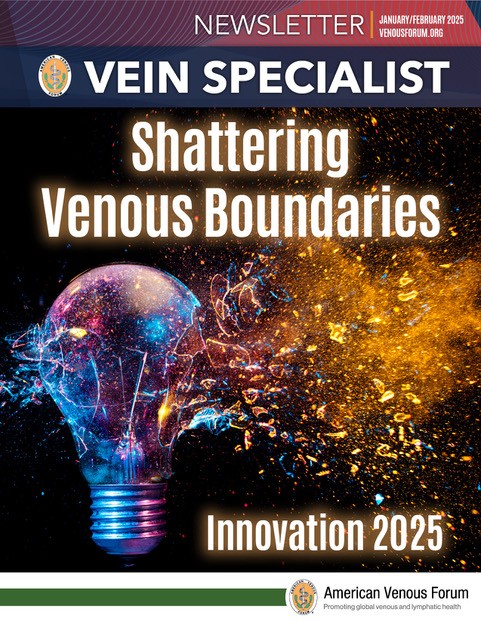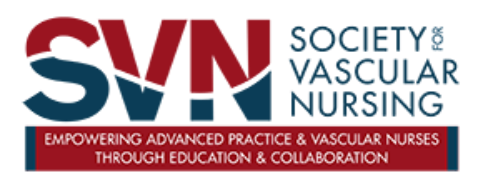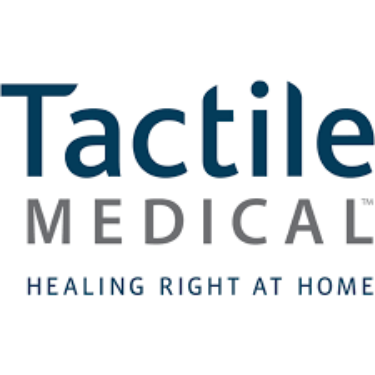
VENOUS2025
POCIT: Point of Care Infrared Thermography
Professor Alun H. Davies, MA, DM, DSC from the Imperial College, London and NHS vascular surgeon at Charing Cross Hospital, along with his team, published a systematic meta-analysis in the November 2024 issue of Phlebology with the conclusion, “Thermography could act as a screening tool in SVI.” Of course, more research is currently underway to further validate this statement.
By using a non-contact, non-radiating, point-of-care temperature measurement tool, the vein specialist might be able to uncover more superficial venous insufficiency more easily, more accurately, and with less cost than ever before. This same method could also identify patients without significant superficial venous disease, thus saving time and unnecessary testing. Point of care infrared thermography (POCIT) seems to be that technology.
Seven years ago, when I first saw thermography on my own insufficient leg veins, the experience was transformative. Not only did it prompt me to begin wearing compression socks and undergo ablation therapy, it also reshaped my perspective on how we approach screening for venous health.
That pivotal moment led to original research in collaboration with university biostatisticians and my esteemed colleague, David Wright, a medical physicist and vascular surgeon who was formerly VP Medical Affairs for BTG (now Boston Scientific). Together, we uncovered a key observation: deeper core venous blood is a few degrees warmer than blood in normal superficial veins, and abnormal incompetent superficial veins have a higher temperature signal similar to the deeper core venous system. This connection leaves a distinct thermographic pattern with refluxing superficial veins thought to only be seen in cases of venous reflux and not in non-refluxing veins. This insight became the foundation of a journey to develop, patent, and secure FDA clearance for thermography’s newest device, ThermPix®.
This journey has recently culminated in the most recent development: the establishment of the Clinical Screening Council (CSC), an initiative directed under the guidance of the American Venous Forum. The CSC is dedicated to advancing research into venous screening tools like POCIT. This multi-society, multidisciplinary effort has engaged key opinion leaders and industry stakeholders to ensure rigorous evaluation and proper adoption of innovative technologies for venous care.
In parallel, our company, USATherm, launched the FDA-cleared medical device ThermPix® in the third quarter of 2024. The response to this groundbreaking technology, both in the US and internationally, has been overwhelming. To meet demand, production at our US- based manufacturing facility was recently increased. Many of the most advanced vein centers in the world are taking advantage of the patient’s educational benefits while gathering useful data that are added to the global database.
In the same time needed to take clinical photographs–currently a guideline from the AVF and requirement by CMS and many healthcare insurers– ThermPix® can simultaneously capture the thermographic evidence emanating from the legs that serves as adjunctive validation of venous insufficiency. Such documentation is helpful for both proper mapping as well as patient education. This results in improved mapping efficiencies in the ultrasound department.
To further enhance ThermPix®’s capabilities, we introduced the ThermPix® App Store, which allows third-party developers to contribute to the POCIT ecosystem. Already, this platform has fostered innovation in areas such as artificial intelligence, automated 3D thermographic mapping, and other applications for vascular health. We anticipate future FDA clearances for these software advances, which will continue to expand the capabilities of ThermPix®.
For inquiries or collaboration opportunities, see www.thermpix.org.

The Innovation Journey:
Transforming Vascular Care through Process Evolution
Innovation in healthcare is not a destination but a continuous journey of reimagining and redesigning care delivery. As nurse practitioners and a board member of the Society for Vascular Nursing (SVN), we have found that true innovation emerges from challenges we face daily in patient care. The process of innovation requires us to question established practices, identify gaps in care, bridge the gaps, and systematically develop solutions that improve patient outcomes.
The SVN is a national organization that supports vascular nurses and nurse practitioners by providing education, collaboration, and practice guidelines. Board members uphold SVN’s values—excellence, respect, advocacy, and mentorship—by fostering an environment where diverse contributions and perspectives spark innovation and education.
Our evolution from nurse to nurse practitioner has shown that meaningful innovation follows a distinct pattern: identify a clinical need, gather stakeholder input, prototype solutions, implement changes incrementally, and continuously evaluate outcomes. This systematic approach to innovation has led to several successful initiatives in our practice. The key is starting with small, manageable changes and building on successes while learning from setbacks.
Innovation often begins with recognition of a problem. In our case, we noticed gaps in post-operative care coordination and follow-up. Rather than immediately implementing
sweeping changes, we started by mapping the current patient journey, identifying challenges, and gathering input from stakeholders– patients, nurses, physicians, and support staff. This collaborative approach to problem-solving revealed opportunities for improvement that might have been missed from a single perspective.
A valuable lesson we have learned through SVN leadership is that successful innovation requires creating an environment where all team members feel empowered to contribute ideas. We have established regular forums where staff can share challenges and propose solutions, leading to process improvements. This bottom-up approach to innovation has proven more effective than top-down mandates by ensuring buy-in from those who will be implementing the changes.
The experience of innovation involves attention to change management. When implementing new care delivery models, we have found that pilot testing, gathering feedback, and making iterative improvements leads to better adoption and sustainability. This approach allows refined processes before full-scale implementation and builds confidence among team members.
Another critical aspect of innovation is measuring outcomes. We have developed robust methods for tracking both quantitative metrics (readmission rates, patient satisfaction scores) and qualitative feedback (staff satisfaction, workflow efficiency). This data-driven approach helps us demonstrate the value of innovations and make cases for further improvements.
Looking ahead, advancing vascular care innovation will increasingly require thinking beyond traditional boundaries and breaking barriers. The experience has taught us that some of the most impactful innovations come from unexpected sources –a nurse’s suggestion about patient education, a medical assistant’s insight about workflow efficiency, or a patient’s feedback about their experience.
Innovation is an unending process. Each solution creates new opportunities for improvement, and each success builds momentum for further change. By maintaining a systematic approach to innovation while remaining open to new ideas from all sources, we can continue to enhance the quality, understanding, and accessibility of vascular care.
Suzanna Fitzpatrick, DNP, ACNP-BC, FNP-BC, FAANP is a Clinical Program Manager at the University of Maryland Medical Center, where she specializes in vascular surgery and leads several innovative patient care initiatives.
Gabriell N. Grayson, DNP, APRN, ACNP-BC, CV-BC is a board member of the Society for Vascular Nursing, and specializes in vascular surgery at Baylor Scott & White, The Heart Hospital, Plano, Texas.

Patient Experience and Preferences Drive Advances
in Pneumatic Compression for Lymphedema Management
Pneumatic compression devices (PCDs) for lymphedema management have advanced markedly since the first commercial device, a single-chamber pump, was manufactured in the United States by Conrad Jobst in the 1950s. Since then, innovations aim to enhance therapeutic effectiveness and patient compliance. Research has shown a strong positive association exists between a patient’s perceived experience with their prescribed therapy and therapeutic outcomes; high satisfaction is a correlate of high treatment adherence.1
Patients are asking for more from their PCDs, requesting a consumer-friendly system that is modern, simplified, and more compact, enabling patients to take their lymphedema treatment device wherever they go. The newest PCD from Tactile Medical®, Nimbl™, is an example of using patient feedback to improve ease-of-use and treatment satisfaction through thoughtful design. In internal Tactile Medical unpublished studies, patients and healthcare providers were surveyed regarding the Nimbl design and experience with the device. In one of these studies (2024), lymphedema patients were asked to compare Nimbl against Tactile Medical’s pre-existing basic PCD, Entre® Plus, and they overwhelmingly preferred Nimbl. In another internal study (2024), healthcare providers reported having a strong preference for the simplicity of the Nimbl design, believing it will lead to higher compliance. These providers also found Nimbl’s unique feature of Bluetooth® connectivity with a mobile application, Kylee™, beneficial for reviewing a patient’s device use and progress, allowing for a more personalized treatment plan.
Feedback from PCD users is crucial for ensuring patient satisfaction, which is the driving force behind daily treatment adherence. Compliance is key for successful lymphedema management. Prior to the Nimbl market release for lower extremity treatment, a preference study was conducted in November 2024 by an independent market research firm, Orman Guidance, to assess treatment satisfaction, perceived efficacy, and identify the most important user-experience categories among prospective users. This 2-arm, randomized trial compared the most prescribed PCDs on the US market: The LV Base from BioTAB Healthcare, the PCD-51™ from Lympha Press®, and the Nimbl. All 31 participants used Nimbl and were randomized to receive either Lympha Press or Bio TAB. The order on which leg the Nimbl garment was worn during the interview was randomized.
When asked, respondents preferred Nimbl, over BioTAB and Lympha Press, in the following categories: travel, ease-of-use, lifestyle fit, daily compliance, comfort using the device around others, and for treatment in the home. After experiencing each treatment, 86% of participants reported that Nimbl offered the most perceptible benefit, as well as 80% of subjects’ describing Nimbl treatment as the best sensation. Nimbl was found to be the most comfortable, preferred for daily use, and best overall treatment experience.
Preference research that investigates what PCD users value most, and what leads to the greatest treatment satisfaction, is important to inform medical device design that meets patient needs. These efforts ensure that product innovation is guided by the voices of current and future patients. When patients have a say, and are heard, in their medical treatments, satisfaction and adherence increase together to improve symptom management and better health outcomes.
Reference:
- Doyle C, Lennox L, Bell D. A systematic review of evidence on the links between patient fxperience and clinical safety and effectiveness. BMJ Open. 2013;3(1). doi:https://doi.org/10.1136/bmjopen-2012-001570

Penumbra’s CAVT™ Technology is Advancing VTE Care
Each year venous thromboembolism (VTE) affects ~900,000 Americans. The associated health care costs in the U.S. equal ~$10 billion each year.1
Penumbra’s computer assisted vacuum thrombectomy (CAVT) technologies are advancing frontline procedures for VTE, including treatment of pulmonary embolism (PE) and procedures for acute limb ischemia (ALI). The latest additions to the Lightning® CAVT portfolio—Lightning Bolt TM12, Lightning Bolt 6X with TraX and Lightning FlashTM 2.0 – are designed for faster clot removal, restoring blood flow rapidly.
Recent data presented at Vascular InterVentional Advances (VIVA) 2024 show that treatment of PE with CAVT resulted in 25% to 35% shorter total hospital length of stay, 25% to 30% higher rate of patients discharge to home rates, and 3.4x lower composite complications compared to patients treated with anticoagulation, catheter directed thrombolysis or other mechanical thrombectomy devices.2,3 Additionally, the STRIDE Study showed that frontline use of Penumbra’s CAVT system for patients with lower extremity ALI resulted in a 88.5% target limb salvage rate and 12% mortality rate at one year, and overall improvement in quality of life.4
“We have a growing body of evidence that demonstrates the meaningful benefits of CAVT on patient outcomes,” said James F. Benenati, M.D., FSIR, chief medical officer at Penumbra. “The latest findings suggest that increasing patient access to CAVT can have a positive impact on outcomes, including complications, length of stay, and health care systems by reducing resource utilization versus other modalities.”
To learn more about CAVT, visit www.penumbrainc.com.
Caution: Federal (USA) law restrictions these devices to sale by or on the order of a physician. Prior to use, please refer to the Instructions for Use for complete product indications, contraindications, warnings, precautions, potential adverse events, and detailed instructions for use. Please visit https://www.penumbrainc.com/pdf/brief-summaries-risk-statement/ for the complete IFU Summary Statements.
Beckman M, Hooper WC, Critchley S, Ortel T. Venous thromboembolism: a public health concern. Am J Prev Med. 2010;38(4 Suppl):S495-501.
2 Retrospective analysis of resource use and health outcomes of 2,060 1:1 propensity score matched patients with intermediate-risk pulmonary embolism (PE) when treated with Lightning 12 and Lightning Flash 1.0 compared to anticoagulation, catheter-directed thrombolysis or other mechanical thrombectomy in the United States. Composite complications is defined by Vizient® and in this study includes: In Hospital Stroke, GI Hemorrhage Prevention, Post Operative Infection, Hospital Acquired AMI, Readmit for Infection Due to Previous Care, Readmit for other complications of internal device/Implant/Graph, Readmit for Other Surgical Wound Complications, Infection/Inflammation Due to Internal Device/Implant/Graph, Post Operative Shock, Aspiration/Pneumonia, C-Diff.
3Patel P, Dohad S, Moriarty J, et al. Healthcare resource utilization and outcomes among patients with intermediate-risk pulmonary embolism treated with computer-assisted vacuum thrombectomy versus other treatment modalities. Presented at: VIVA (Vascular InterVentional Advances) 2024; 04 November 2024; Las Vegas, NV.
4Maldonado TS, Powell A, Wendorf H, for the STRIDE Study group. One-year limb salvage and quality of life following mechanical aspiration thrombectomy in patients with acute lower extremity ischemia. J Vasc Surg. 2024. Published online. doi: 10.1016/j.jvs.2024.05.043
Innovation in Venous and Lymphatic Health:
Insights from Methapharm
Innovation is the lifeblood of progress, and at Methapharm, we are committed to advancing specialty medicine. We entered the venous treatment space by distributing Asclera® in February 2022 because we strive to bring novel, compelling products to market and actively support clinicians in integrating them. We have learned a lot in 3 years and expanded our product offering by launching ScleroSafe™ in early 2024. With a focus on partnership and education, branding, and a unique engagement strategy, we endeavor to support and empower clinicians and practices across the country.
At the core of Methapharm’s DNA is our emphasis on partnership. Methapharm is a private, family-owned business. We pride ourselves on our agility and mobilization of personnel and funds to where they would make the most impact. We are continually evaluating the needs of healthcare providers and patients to identify gaps in treatment, ever on the lookout for products in underserved therapeutic areas in a bid to make them available. When we bring these products to market, as with Asclera and ScleroSafe, we evaluate the gaps and opportunities to incorporating them into practice. We strive to become active partners with our customers, clinic groups, and societies.
With education in mind, we have developed a host of tailored learning resources to support healthcare professionals across the country, from webinars to workshops, empowering them with the knowledge needed to integrate our solutions into their practice. Methapharm has hired a dedicated team of senior clinical advisors with years of experience in vein treatment to form the cornerstone of these initiatives. Educational guidance and support can be found virtually through online resources at www.aslcera.com or www.sclerosafeus.com. Information about how to inject, testimonials, clinical papers, and other resources are available on those sites.
At Methapharm, however, we recognize that innovation extends beyond the products themselves—it’s also about how we are perceived by and connect with customers. At major vein conferences such as VENOUS2025, we aim to create an experience to help make who we are, and what we represent, more memorable; for example, wearing colorful scrubs with complementary booth designs and materials. We aim to connect in an authentic way with our partners and foster a culture of belonging. This is not mere window dressing; we strive to be right alongside you on your sclerotherapy journey.
Innovation is as rewarding as it is challenging. At Methapharm, we’ve learned that success requires a willingness to embrace change, take calculated risks, and surmount obstacles through clear communication and dogged determination. Entering the venous space to begin with was a substantial and challenging undertaking for our organization, but one we were confident in pursuing. We are certainly happy we did.
We look forward to our continued partnership with the AVF and you, its members. See you at VENOUS2025!










